
Carr of York's original design for the North Facade from "Vitruvius Britannicus"
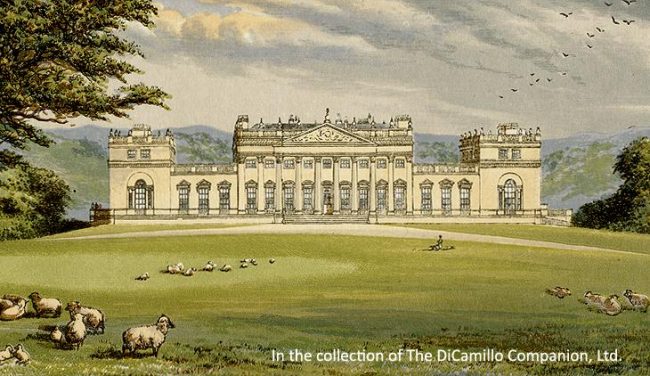
A circa 1875 lithograph of the Entrance (North) Facade from "Morris's Views of Seats"
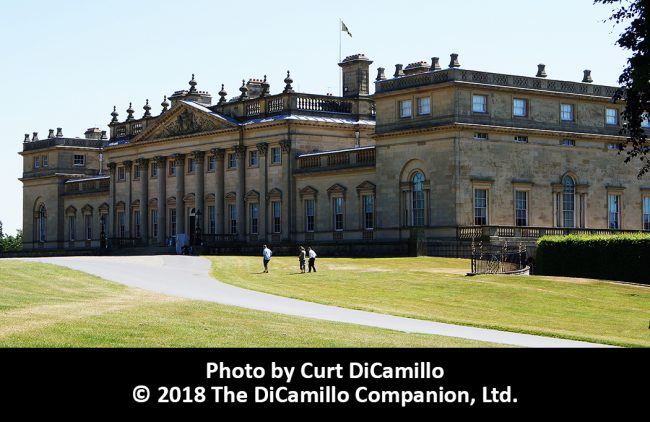
The Entrance (North) Facade today

Carr of York's original design for the South Facade from "Vitruvius Britannicus"
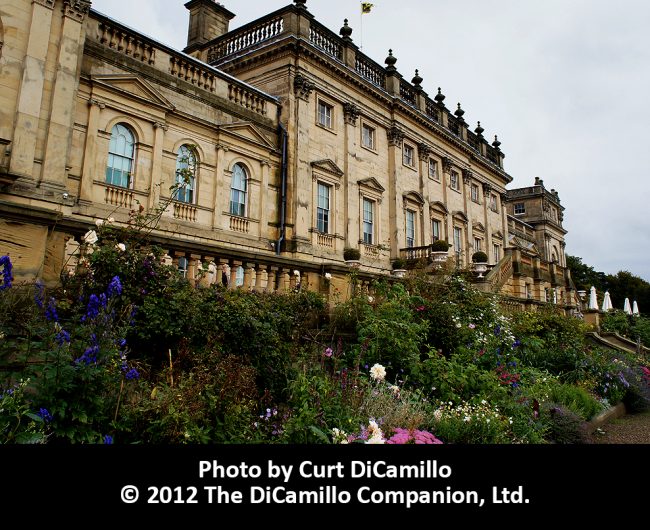
The South Facade today
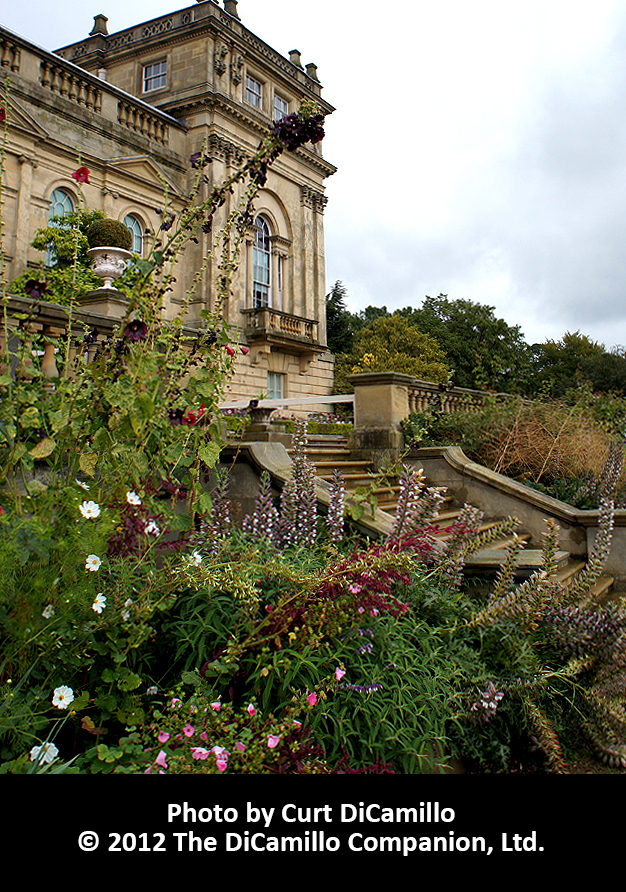
The Terrace Garden on the South Facade
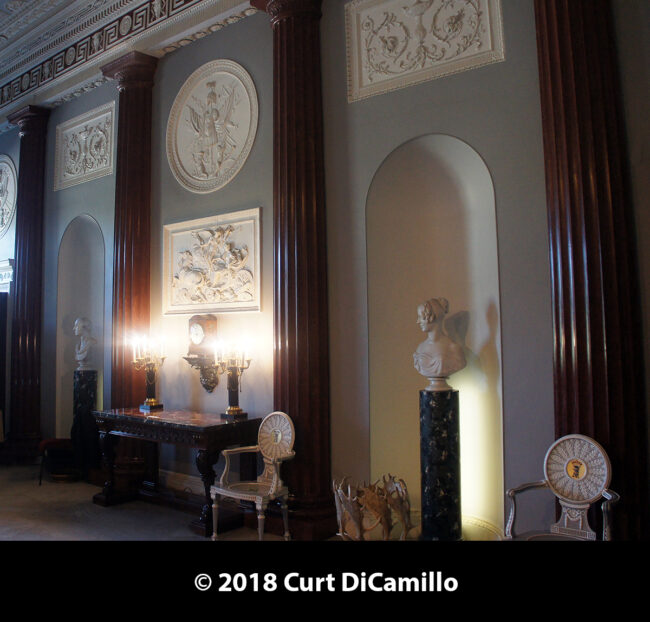
Adam's Entrance Hall
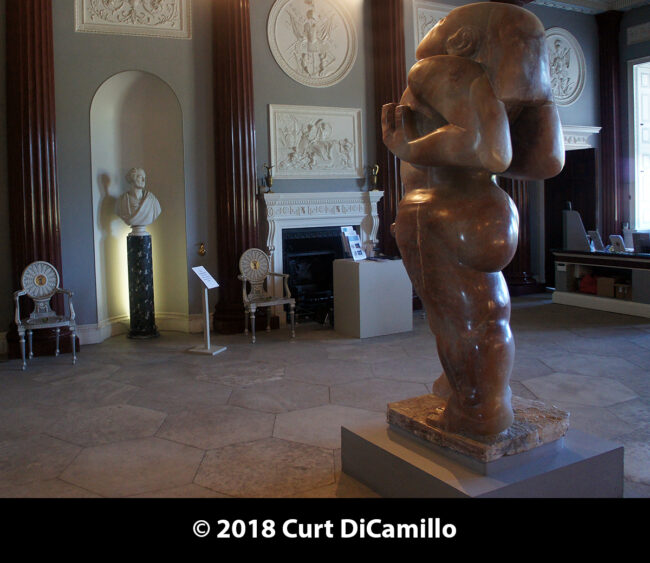
Jacob Epstein's monumental "Adam" in the Entrance Hall
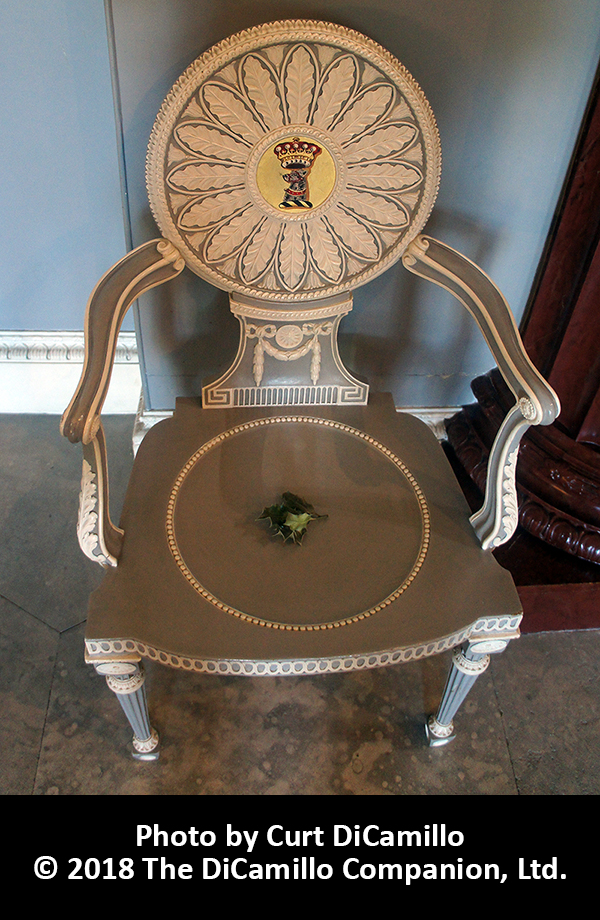
One of a set of eight beechwood hall chairs made for the Entrance Hall by Chippendale. The chairback features armorial elements of the Earls of Harewood.
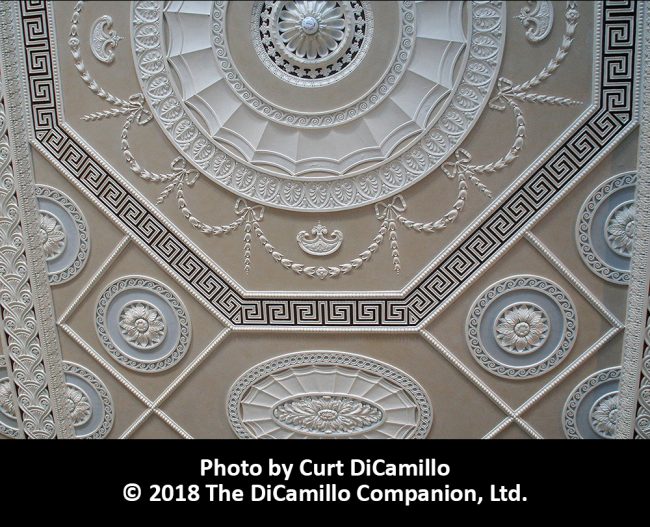
The Entrance Hall ceiling
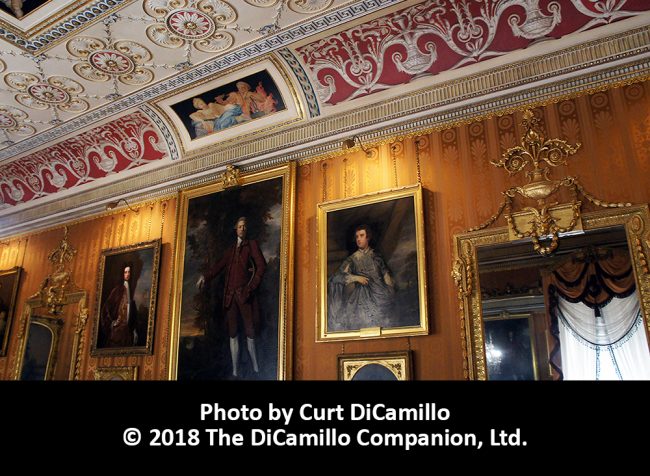
The Cinnamon Drawing Room
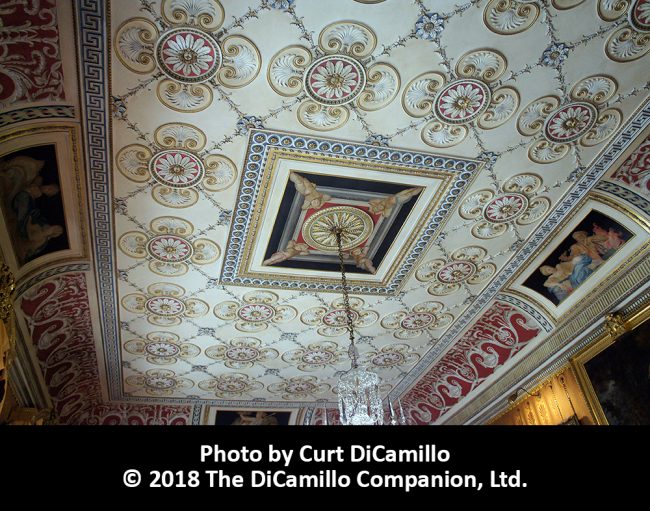
The Cinnamon Drawing Room ceiling
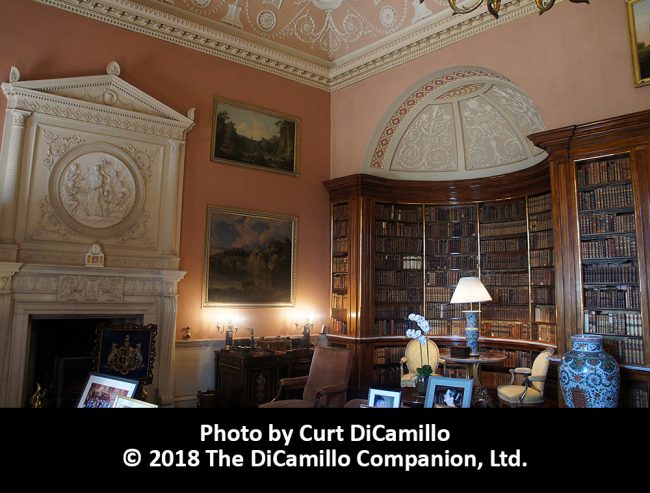
The New Library
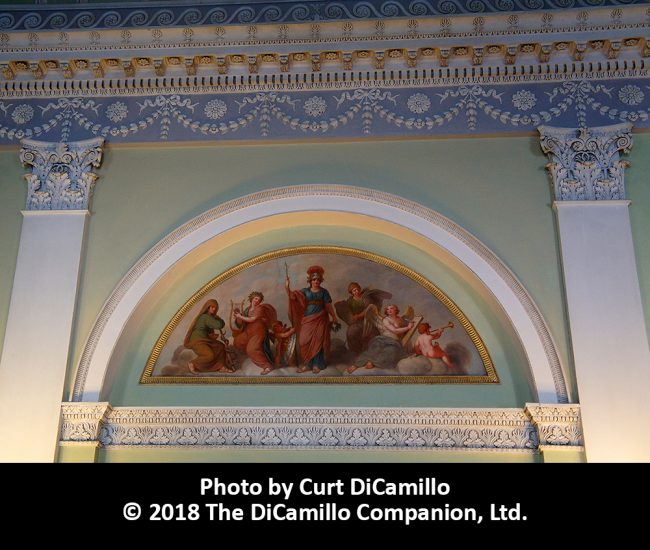
Biagio Rebecca's "The Triumph of Homer," with Minerva in the middle, in the Old Library.
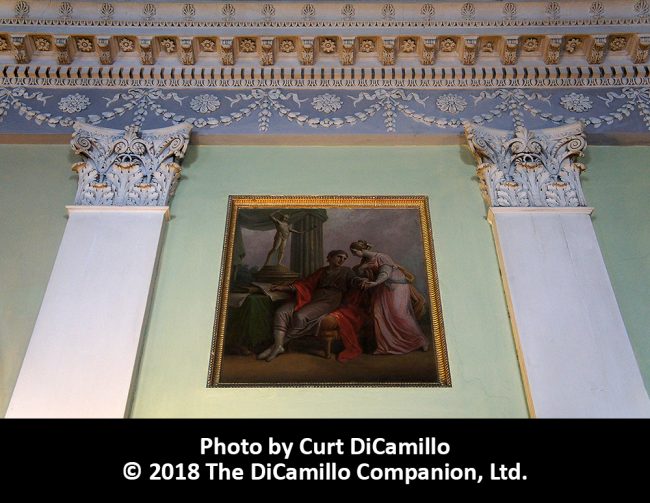
Biagio Rebecca painting over a bookcase in the Old Library
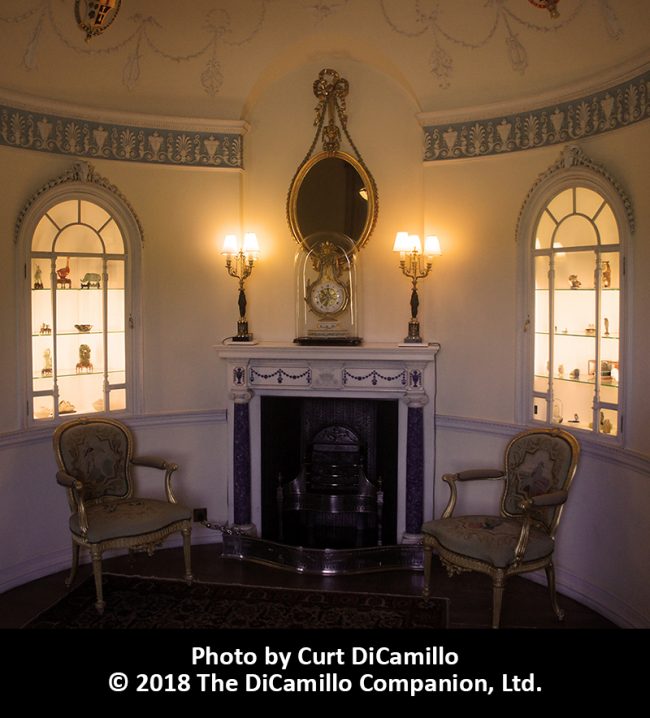
Princess Mary's Dressing Room, designed in the 1930s by Herbert Baker to complement the existing Adam interiors. Baker incorporated features taken from the family's London house, Harewood House in Hanover Square, which was demolished in 1908.
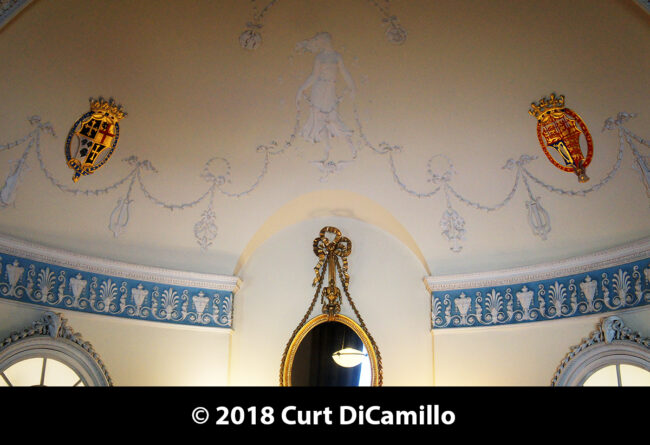
Plasterwork in Princess Mary's Dressing Room designed by Sir Charles Wheeler in the 1930s. In the middle is a nymph inspired by Botticelli; to the left are the arms of the 6th Earl of Harewood, and, to the right, the arms of his wife, The Princess Royal.
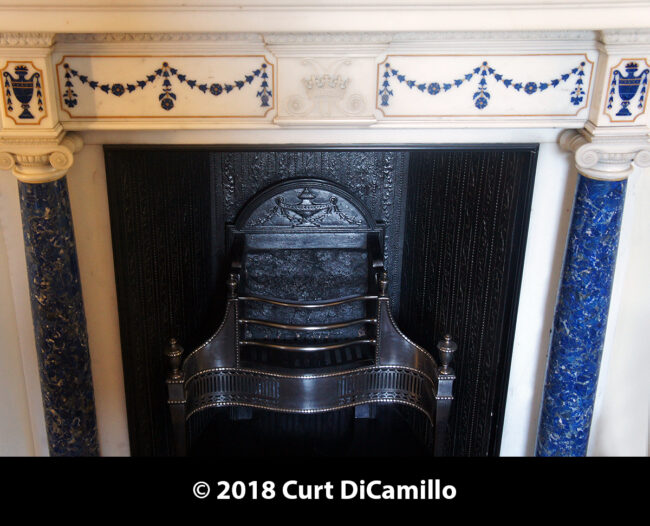
The fireplace in Princess Mary's Dressing Room
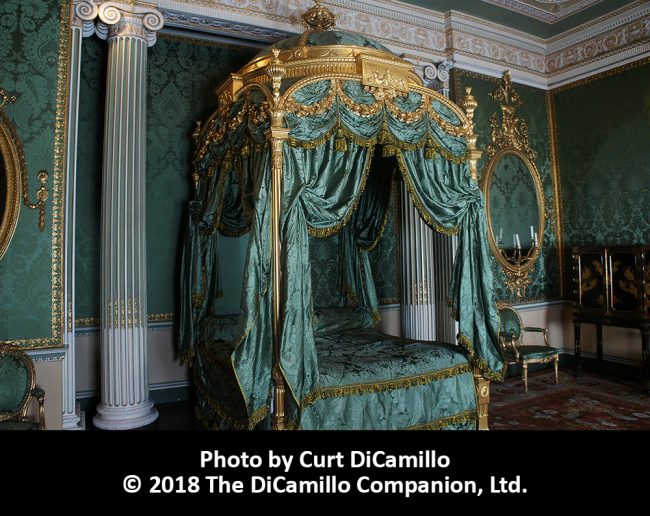
Chippendale's State Bed in the State Bedroom
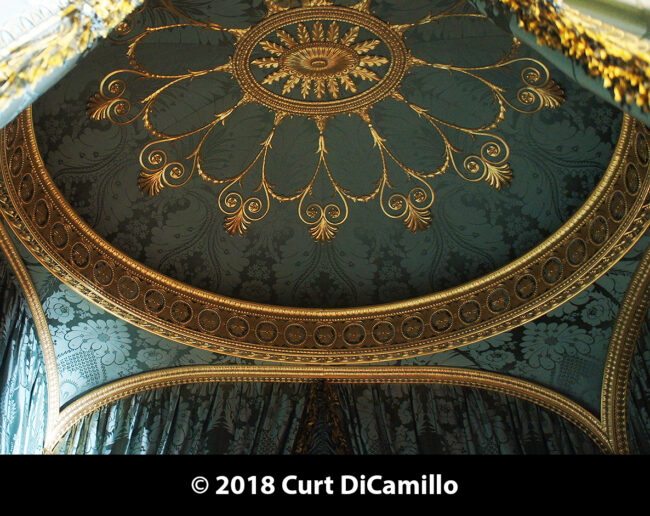
The interior of the dome of Chippendale's State Bed
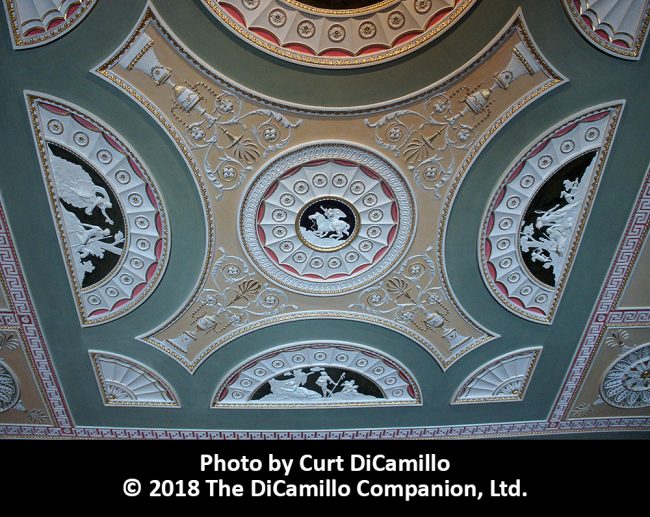
The State Bedroom ceiling
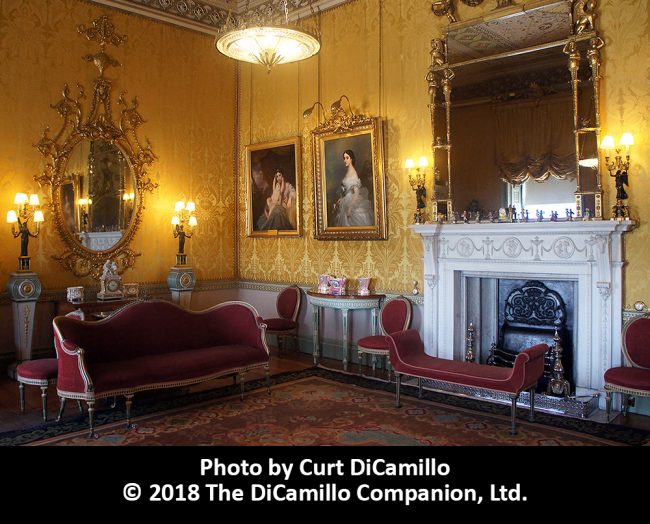
The Yellow Drawing Room
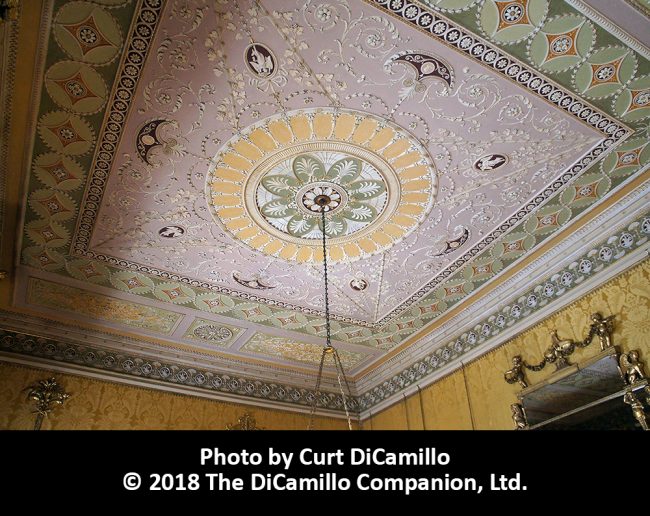
The Yellow Drawing Room ceiling
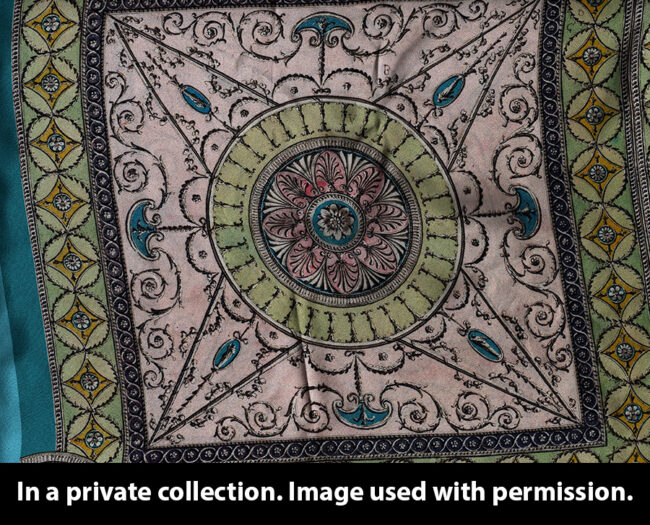
Full view of the silk scarf of the Yellow Drawing Room ceiling
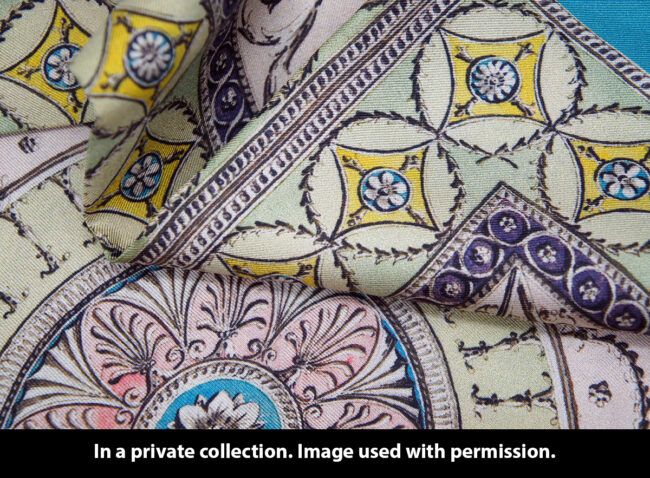
Detail of a silk scarf that features the design of the ceiling of the Yellow Drawing Room
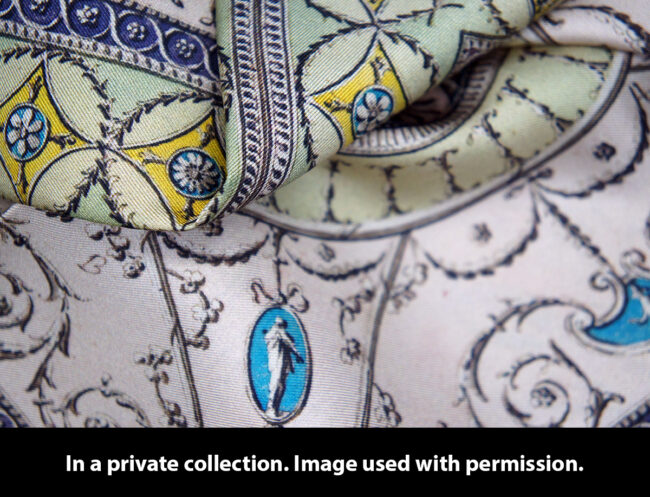
Detail of a silk scarf that features the design of the ceiling of the Yellow Drawing Room
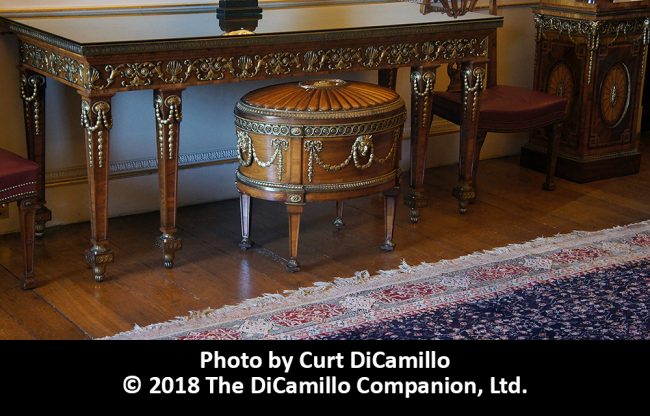
Chippendale sideboard and wine cooler in the State Dining Room
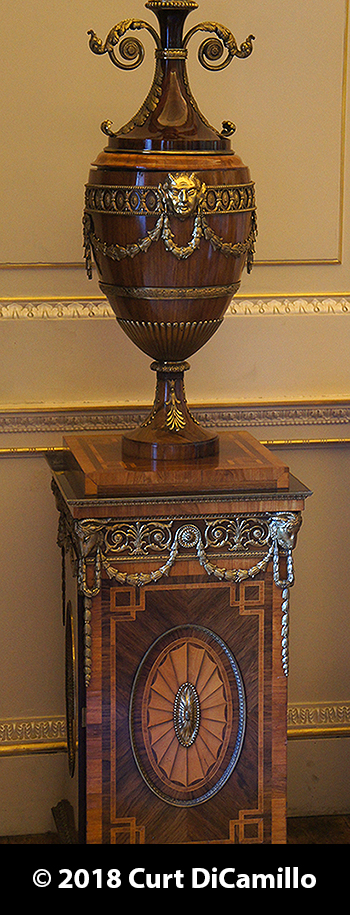
Chippendale's urn on a pedestal in the State Dining Room. These pieces are considered among the finest pieces of English furniture ever created.
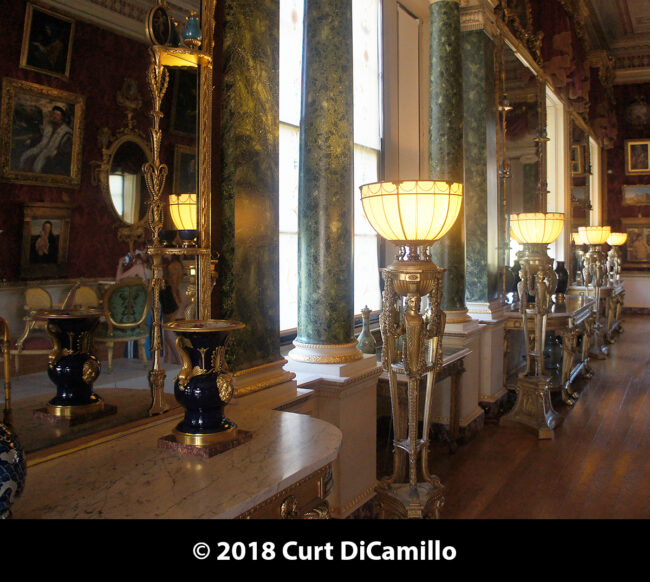
The Gallery, with torchères, mirrors, and tables carved by Chippendale the Younger.
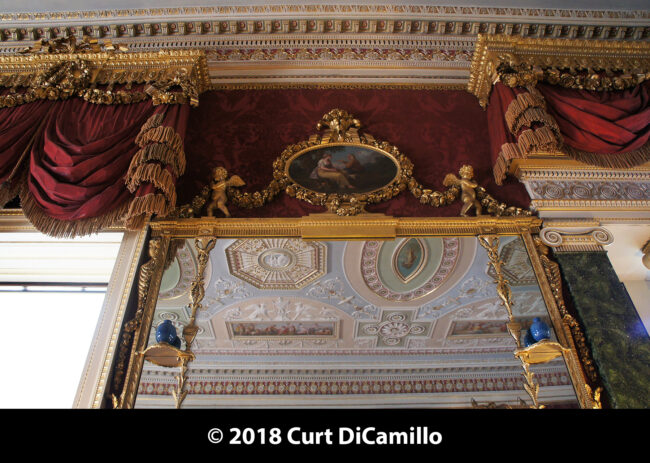
The Gallery features this pier glass (with oval painting by Angelica Kaufmann), pelmets, and red curtains, all made by Chippendale the Younger. The faux curtains are carved in wood to imitate heavy fabric.
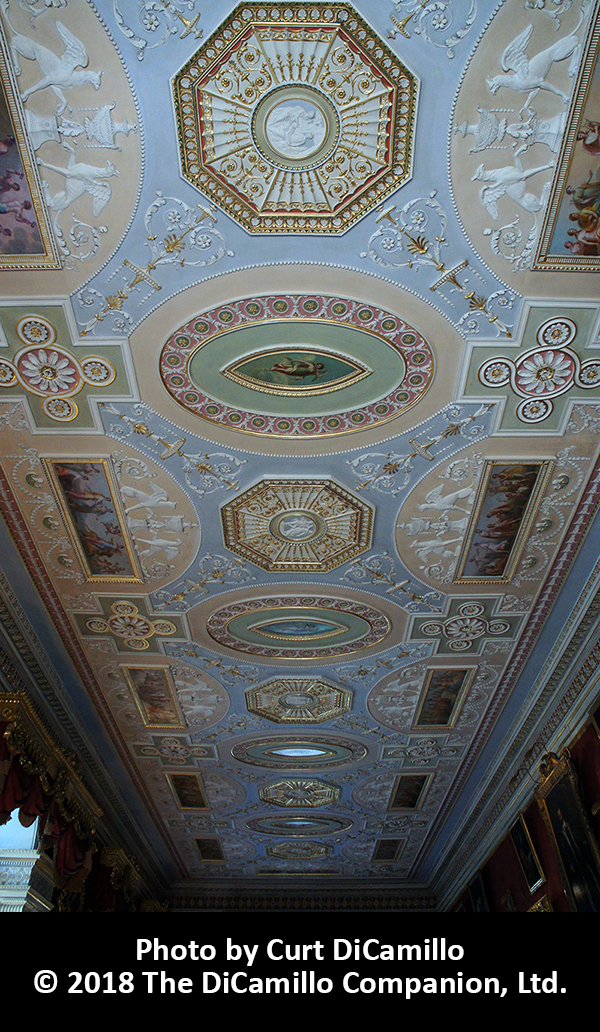
The Gallery's Palmyran-inspired ceiling, designed by Robert Adam and executed by Joseph Rose.
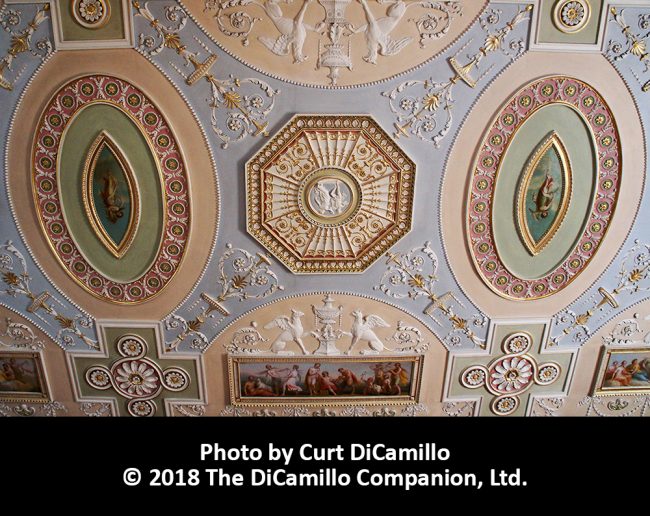
The Gallery ceiling features the exploits of Greek gods and goddesses painted by Biagio Rebecca
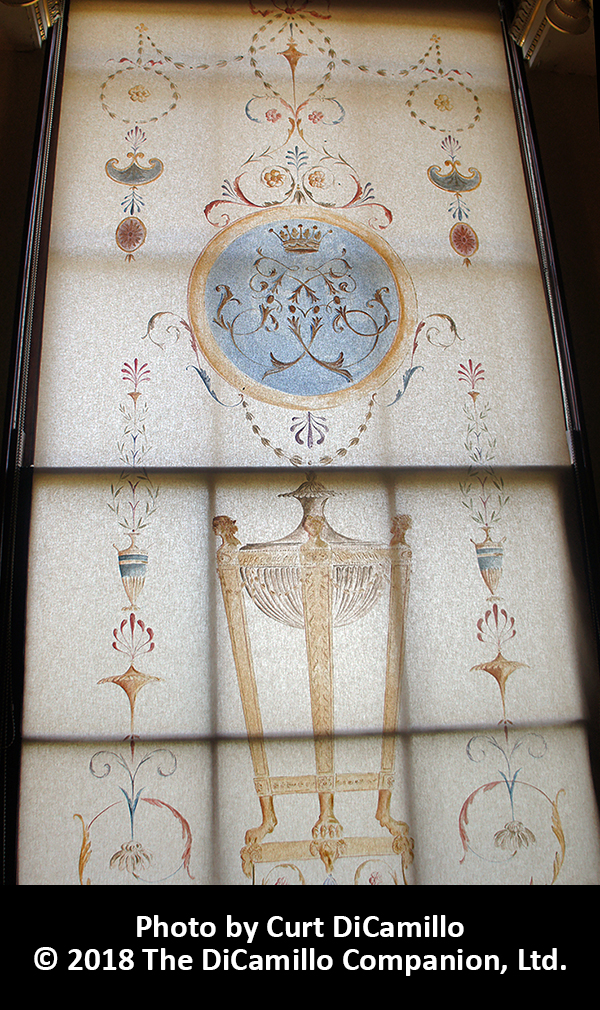
One of Alec Cobbe's 1990s hand-painted Gallery shades
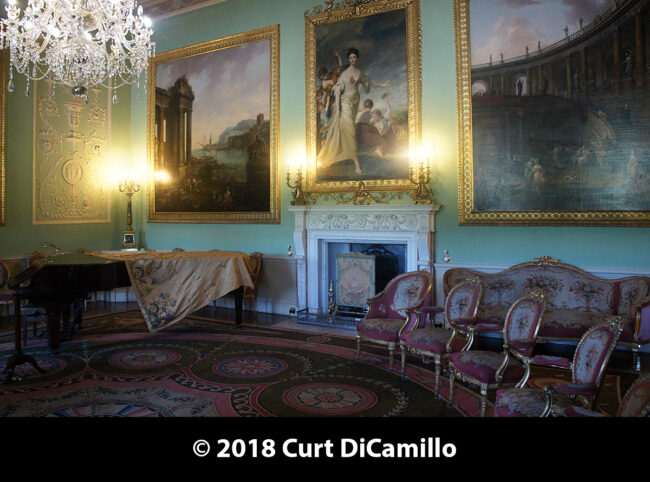
The Music Room
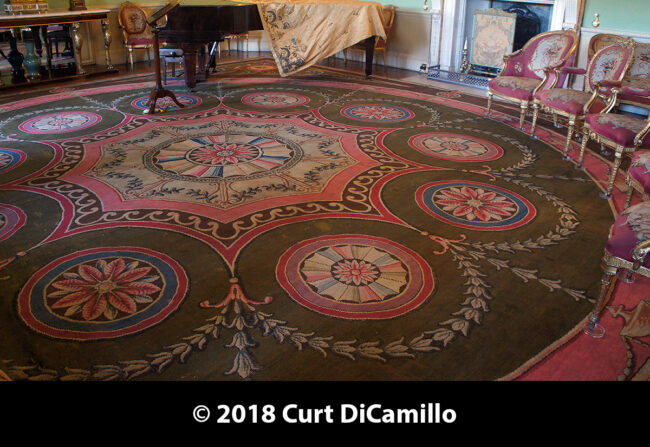
The Music Room carpet
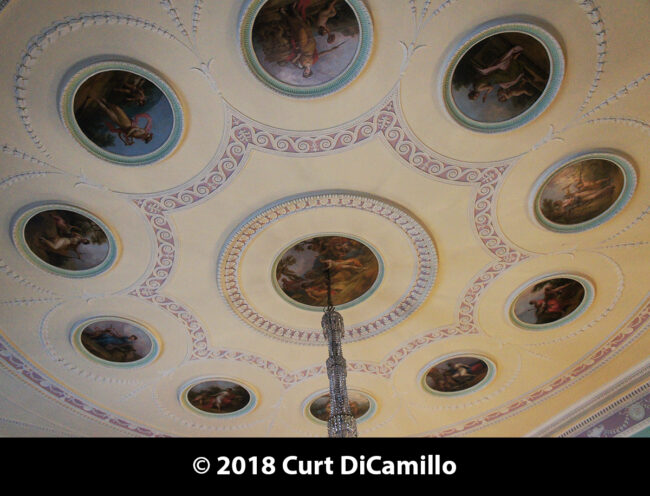
The Music Room ceiling, with roundels painted by Angelica Kaufmann and Antonio Zucchi.
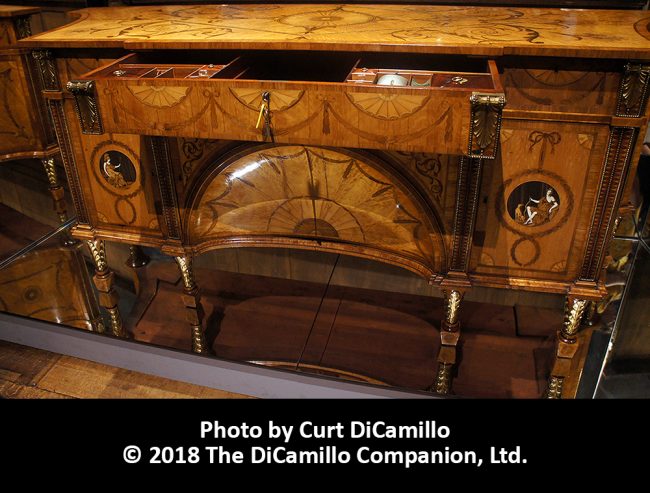
The Chippendale Minerva and Diana Commode
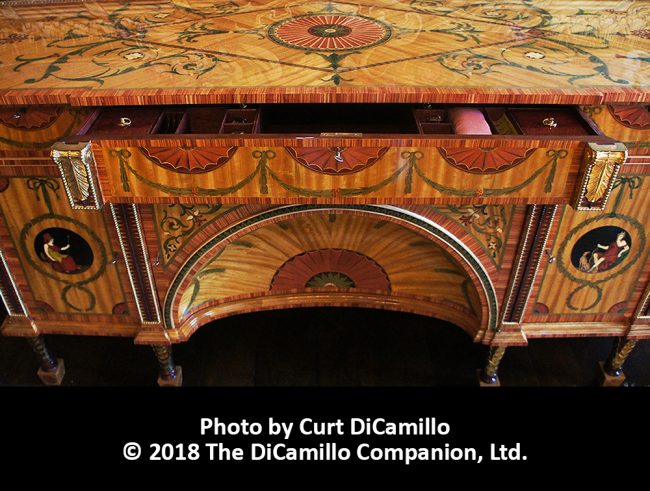
The 1990s reproduction of the Harewood Chippendale Minerva and Diana Commode, today at Newby Hall.
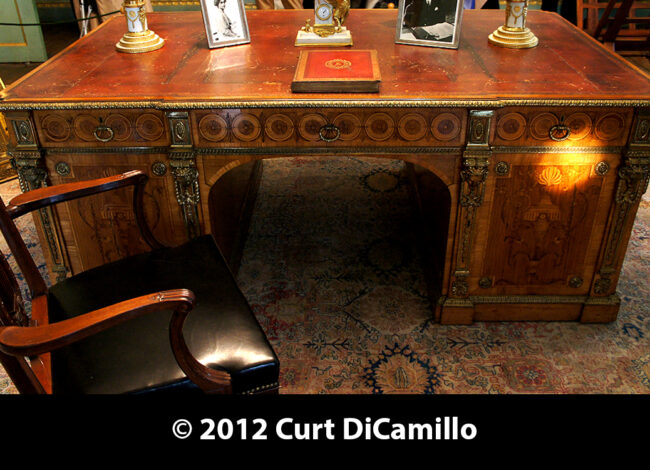
1771 desk made by Chippendale for the library at Harewood; since 1965 in the collection of Temple Newsam.
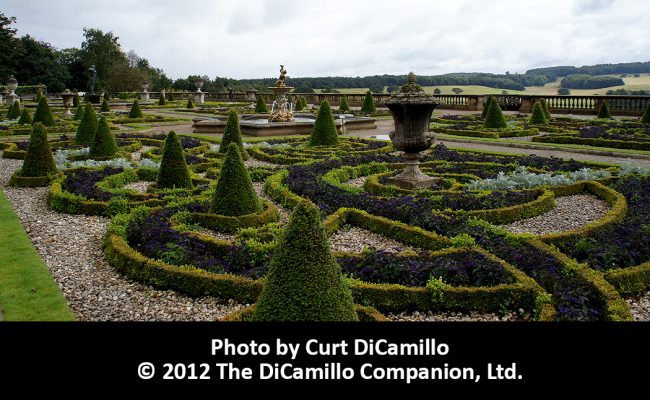
The Terrace Garden
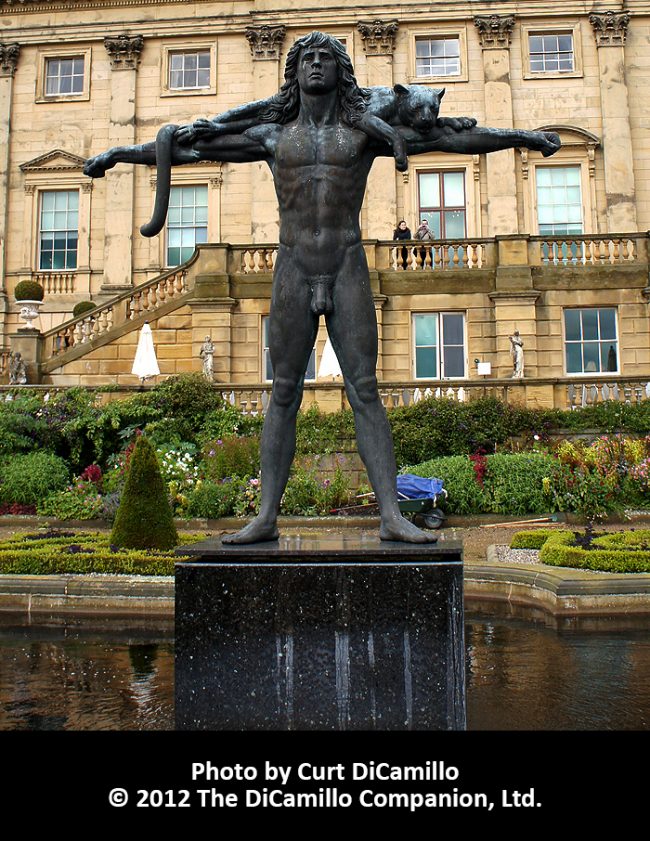
Orpheus and the leopard (1984) by Astrid Zydower in the Terrace Garden
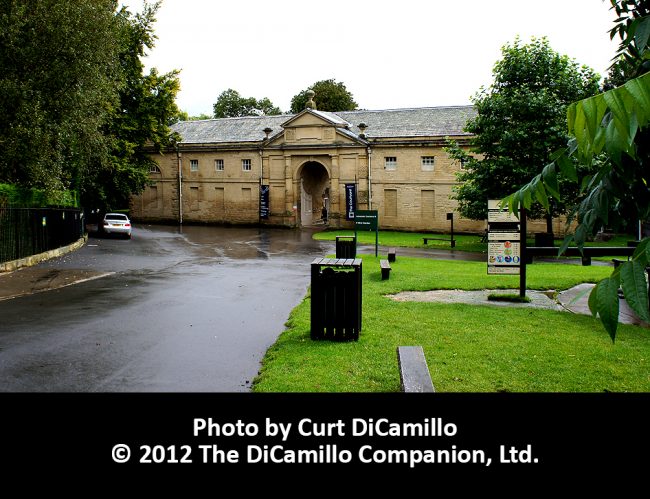
The Stableblock
Earlier Houses: Gawthorpe Hall, a large Elizabethan manor house built circa 1480, stood between Harewood House and the stables; this house was completely demolished in 1771, once Harewood House had been completed. The ruins of the Grade I-listed Harewood Castle, built in the mid-12th century by Robert de Lisle and occupied until the 16th century, are northeast of Harewood House.
Built / Designed For: Edwin Lascelles, 1st Baron Harewood
House & Family History: Harewood House is a testament to the business acumen of Henry Lascelles, an 18th century trader involved in commerce in the West Indies, including the slave trade (the Lascelles family had owned sugar plantations in Barbados since the late 17th century; by the 18th century the family owned or controlled 24 plantations in Barbados and other Caribbean islands that were worked by 3,000 enslaved individuals). So successful was Lascelles in his business ventures that he purchased the Estate of Gawthorpe, between the site of Harewood House and the lake. Lascelles's son, Edwin, later 1st Baron Harewood, inherited Gawthorpe and the adjoining Harewood Estate on his father's death in 1753 and devoted his energies to creating on his new lands a grand country house estate. Edwin chose as his architect the young John Carr (of York), who created one of his masterpieces (the plan and exterior were substantially Carr's design, but the interior decoration of the principal rooms was the work of the famous Robert Adam and his brother John). Carr was also responsible for much of Harewood Village, the Stables, and the Temple of Venus (demolished). The architect used local millstone grit for the house exterior; even the interior bricks and stucco came from Lascelles land. Carr created a house composed of a central block joined by single-story links to wings on either side. The front entrance is through a massive pediment supported by six engaged Corinthian columns. Harewood cost the immense sum of £37,000 to complete, the equivalent of approximately £66 million in 2019 inflation-adjusted values, using the labour value commodity index. An interesting architectural footnote is that the design for the Casino Marino, Ireland's first Neoclassical building, was originally conceived as an end pavilion for Harewood House that was never built. Lascelles had a reputation as a man with a close eye on his purse-strings, but this did not stop him from commissioning Robert Adam to create his interiors, or hiring Thomas Chippendale to fill the House with exceptional furniture. Chippendale complained that, by 1777, he had worked on Harewood for almost eight years and been paid next to nothing (Harewood was the largest commission ever undertaken by Chippendale). However, the result of his endeavors, and those of Adam and Carr, produced at Harewood one of the most superb examples of the English country house ever built. For the sumptuous Neoclassical interiors Adam partnered with some of the finest artists and craftspeople of the age, including Joseph Rose for the plasterwork (particularly the ceilings) and Biagio Rebecca and Angelica Kaufmann for roundels and mythological paintings. The Gallery, considered one of Adam's most magnificent achievements, takes up the entire length of the west end of the House. The room measures 76 feet long by 24 feet wide by 21 feet high and is hung with a glorious collection of Renaissance paintings and furnished with mirrors, torchères, tables, and faux curtains by Chippendale the Younger. The classical symmetry of the original exterior design was altered by Sir Charles Barry in the 1840s, when an Italianate balustrade was added to the roofline and a third story piled onto the House, severely changing its elegant classical symmetry (Barry was also responsible for demolishing the classical portico on the South Facade and adding the Terrace Garden). The 7th Earl of Harewood wrote that Barry transformed the South Facade "...into something like an Italian palazzo." The garden gives access to the Terrace Gallery, today an art exhibition space in what was originally the Sub Hall, where a changing schedule of exhibitions and special events makes a variety of art accessible to visitors. By the early years of the 20th century the financial position of the Lascelles family was at low ebb. In 1916, however, a lucky meeting changed the family fortunes: Henry, Viscount Lascelles, then a Grenadier on leave from his duties at the front during World War I, happened to meet his immensely rich, but miserly, uncle, the eccentric 2nd Marquess of Clanricarde, at his London club. The younger man shared a pleasant hour of conversation with his relation; when the marquess died some months later, he surprisingly left his huge fortune to Lascelles. This same Henry Lascelles, later the 6th Earl, married Mary, The Princess Royal (daughter of King George V and Queen Mary), at Westminster Abbey on February 28, 1922. Between them, the 6th Earl and the princess royal initiated a program of restoration at Harewood, added to the art collection, and opened the House to the public (Harewood was the first royal house open to the public). Their son, the 7th Earl, was the founding editor of "Opera" magazine and director of the English National Opera. Harewood's first guidebook was published in the early 19th century. Around the same time, in 1835, the 16-year-old Princess Victoria (later Queen Victoria) stayed at Harewood. During both World War I and II Harewood served as a convalescent hospital for wounded soldiers. Just before the destruction of Pontefract Park in the 1960s, its six-foot-wide grand staircase was removed and reinstalled at Harewood. In 1990 Alec Cobbe redid many of the most important interiors at Harewood in a luscious Neoclassical style. Harewood was one of the first privately-run stately homes in Britain to be awarded museum status by the government.
Collections: The art collection includes sculpture by Thorvaldsen and Lorenzo Bartolini and paintings by El Greco ("Allegory"), Titian (Francis I), Del Piombo, Tintoretto, Veronese, Zucchi, Biagio Rebecca, Gainsborough, Lawrence, Romney, Reynolds, Turner, Winterhalter, Sargent, and Munnings, in addition to excellent examples of Sevres (the Music Room contains a Sevres clock that may have belonged to Marie Antoinettte) and Chinese porcelain. Harewood also contains a collection of British watercolors of national importance, with pieces by Turner, Girtin, and Varley. The Chippendale furniture, original to the House, is generally agreed to be the finest collection of Chippendale in the world (Thomas Chippendale was born in 1718 in Otley, just a few miles from Harewood). Chippendale's over-the-top state bed is unique (Chippendale never made another one like it; see "Images" section). The bed, restored in 1999 at a cost of £200,000, has almost never been occupied; Princess Victoria, who laid her royal head upon its pillows in 1835, is one of the few people known to have slept in the bed. The pair of urn-topped pedestals (the urns are lead-lined wine coolers) that Chippendale made for the Dining Room are considered among the finest pieces of English furniture ever made (see "Images" section). The set of eight painted beechwood hall chairs, made by Chippendale for the Entrance Hall (see "Images" section), remain in their original places today. The desk made in 1771 by Chippendale for the Library at Harewood came into the collection of Temple Newsam in 1965. It was that same year that the 7th Earl of Harewood placed the oak, rosewood, beech, pine, mahogany, holly, tulipwood, satinwood, and sycamore desk for sale with Christie's. The price that the desk fetched, £43,050, was a world record at the time for a piece of English furniture at auction (see "Images" section). In July 1986 a pair of girandoles by Chippendale, made for the Yellow Drawing Room, were sold to an American party for £462,337. There is also a fine collection of 20th century art, most notably Jacob Epstein's colossal statue of Adam (see "Images" section), which the artist carved from a single block of alabaster between 1938 and 1939. The statue was brought to Harewood in the 1960s; it has had pride of place in the Entrance Hall since 1976, where the original Adam gazes at Robert Adam's luscious plaster ceiling. The great Regency silversmith Paul Storr produced, 1812-13, a pair of silver-gilt copies of the Warwick Vase as part of a 50-piece dessert service commissioned by Edward Lascelles to commemorate his elevation in the peerage to 1st Earl of Harewood. A 74-piece creamware (faience fine) dinner service made circa 1790-1800 by the French firm of Stone, Coquerel and Legros d'Anisy that shows transfer printed sepia scenes of churches and houses in Britain, as well as French scenes, is in the collection at Harewood (the British views were taken from the 1779 publication "Seats of the Nobility" by W. Watts). The service was given by Queen Mary to her daughter, The Princess Royal, who married the 6th Earl of Harewood. Four of the plates (showing Wentworth Woodhouse, Harewood House, Glamis Castle, and Sandbeck) appeared in the seminal 1985-86 exhibition "The Treasure Houses of Britain" at the National Gallery of Art in Washington, DC. In a December 5 and 9, 2012 Christie's sale, 36 pieces of the dessert service from the set (showing French scenes) sold for £16,250 (total proceeds from the two-day sale were £4.6 million). In 1972 Titian's painting, "Death of Actaeon," which had been acquired in 1919 from the 3rd Earl Brownlow, was sold via Christie's for £1,763,000 to The National Gallery, London, avoiding its planned sale to the J. Paul Getty Museum in Los Angeles. Some further contents were sold on July 2, 1985. Queen Victoria’s dainty sapphire and diamond coronet (it’s just 4.5 inches wide), designed for her in 1840 by Prince Albert and made in 1842 by Joseph Kitching for £415, is today in the collection of the Victoria & Albert Museum (the queen is wearing the coronet in her famous 1842 portrait by Winterhalter, today in the Royal Collection). Prince Albert commissioned the coronet (11 gold-mounted sapphires surrounded by silver-mounted diamonds) as part of a larger sapphire and diamond parure, which remained in the royal family until 1922, when George V gave the coronet and its accompanying parure to his only daughter, Princess Mary, when she married Viscount Lascelles, later 6th Earl of Harewood. After Princess Mary’s death in 1965, the parure, together with the majority of princess’s jewel collection, was sold at auction; the coronet, however, remained in the ownership of the Harewood family until the early 21st century, when it was probably sold to pay death duties after the death of 7th Earl in 2011. In August of 2016 the coronet was sold by a London dealer to a foreign buyer for £6 million, but the UK government placed a ban on its export until December 2016 to give a British institution the opportunity to raise the money to keep the coronet in the country. In 2017 it was announced that the Irish American hedge fund manager William Bollinger had purchased the coronet and donated it to the V&A, who put it on public view in 2019 in the newly christened William and Judith Bollinger Jewellery Gallery. In 2021 the London dealer Ronald Phillips listed for sale (for £100,000) a circa 1780 round giltwood mirror made by Thomas Chippendale for the White Drawing Room at Harewood. Possibly designed by Robert Adam, this rare circular mirror with griffin candle holders, was originally part of a set of four round mirrors commissioned for Harewood. In January of 2025 Christie's brokered a private sale for £25 million of the Reynolds portrait of Lady Worsley from Harewood to American billionaire Steve Schwarzman, who is expected to hang the painting in his Wiltshire country house, Conholt Park.
Garden & Outbuildings: Not content with finishing the house in grand fashion, the 1st Lord Harewood brought in Capability Brown to level the old house at Gawthorpe and landscape the estate. This Brown did in his usual grand, sweeping style, creating an open vista of parkland dotted with carefully placed trees and paths to accent specific views. Prior to Brown's intervention, a stream had been dammed to create a large lake; today a walk skirts the edge of the lake, moving along a path shaded by overhanging trees, and ends at the rose garden, a profusion of color in the spring and summer months. There is also the walled garden, where, for over 200 years, vegetables have been grown for Harewood House. Carr of York hired Atkinson for work at the house, including the gateway and farm buildings for the 1st Earl of Harewood, circa 1803. A waterfall spills over the dam below the lake, passing a rock garden replete with primulas, astilbes, hosta, and the water-loving gunnera, a giant member of the rhubarb family that grows to eight or nine feet each summer. Pride of place must go to the rhododendron, which grows in splendid profusion along the lakeside walk. Harewood is home to the popular Bird Garden, where visitors can see over 120 varieties of exotic birds, including many species that are under threat of extinction. The birds are, as much as possible, housed in a natural environment, with special areas set aside for cranes, penguins, tropical birds, flamingos, Egyptian geese, and a variety of waterfowl, to name only a few. The Harewood Bridge was designed in 1771 by John Carr of York. The nine-feet-tall bronze statue of Orpheus with a leopard (see "Images" section) by the British sculpture Astrid Zydower (1930-2005) was commissioned by the 7th Earl of Harewood in 1984 to replace a smaller stone statue that had disintegrated in 1982 due to frost damage. The statue stands in the middle of the central fountain of the terrace garden. The four stone urns that surround the central fountain were purchased in 1937 by the 6th Earl and came from Clumber Park. In 1988 the 7th Earl sold part of the estate for £13 million to help fund the restoration of the house and gardens.
Chapel & Church: On the Harewood Estate is All Saints' Church, originally a 15th century church (sitting on pre-Norman foundations), that has been rebuilt many times over the centuries. The church, today in the care of The Churches Conservation Trust, was declared redundant in the 1960s, but remains open to the public for occasional services. All Saints' contains one of the largest and finest collections of medieval monuments in any English church (outside a cathedral), including those of the Gascoigne, Redmayne (Redmand), and Ryther families. One of the Gascoignes buried here is Sir William Gascoigne, the judge immortalized (probably apocryphally) by Shakespeare in "Henry IV, Part One" for sentencing the young Prince Hal (later Henry V) for bad behavior.
Architect: William Belwood
Date: Circa 1765-70sArchitect: Peter Atkinson
Date: Circa 1803Architect: Charles Barry Sr.
Date: 1843-50Architect: John Carr
Date: 1755-80Architect: Robert Adam
Date: 1765-77Architect: Herbert Baker
Date: 1930sVitruvius Britannicus: C. V, pls. 23-28, 1771.
John Bernard (J.B.) Burke, published under the title of A Visitation of the Seats and Arms of the Noblemen and Gentlemen of Great Britain and Ireland, among other titles: 2.S. Vol. I, p. 69, 1854.
John Preston (J.P.) Neale, published under the title of Views of the Seats of Noblemen and Gentlemen in England, Wales, Scotland, and Ireland, among other titles: Vol. V, 1822.
Country Life: XXXVI, 18 plan, 1918. LI, 243 plan, 1922.
Title: John Carr of York: Collected Essays
Author: Hall, Ivan; Powell, Kenneth (Editor)
Year Published: 2023
Reference: pg. 148
Publisher: Winchester: Carriana Publishing
ISBN: 9781399959155
Book Type: Hardback
Title: Harewood Guidebook - 2017
Author: Lascelles, David
Year Published: 2017
Reference: pgs. 29, 54
Publisher: Oxford: Baseline Arts Ltd.
ISBN: NA
Book Type: Softback
Title: Harewood Guidebook - 1990s
Author: 7th Earl of Harewood
Year Published: NA
Reference: pgs. 4, 5, 7, 8, 9, 10, 12, 13, 15, 17, 20, 22, 23, 25, 26, 29, 31, 35, 36, 37, 39, 41, 44, 45, 47, 50, 55
Publisher: Yorkshire: Harewood House Trust Ltd.
ISBN: 0952102145
Book Type: Softback
Title: Alec Cobbe: Designs for Historic Interiors
Author: Bryant, Julius
Year Published: 2013
Reference: pg. 37
Publisher: London: V&A Publishing
ISBN: 9781851777723
Book Type: Softback
Title: Treasure Houses of Britain, The - SOFTBACK
Author: Jackson-Stops, Gervase (Editor)
Year Published: 1985
Reference: pg. 494
Publisher: Washington, DC: National Gallery of Art (New Haven: Yale University Press)
ISBN: 0300035530
Book Type: Softback
Title: Warwick Vase, The
Author: Marks, Richard; Blench, Brian J.R.
Year Published: 1979
Reference: pg. 22
Publisher: Glasgow: Glasgow Museums and Art Galleries
ISBN: 0902752073
Book Type: Light Softback
Title: Creating Paradise: The Building of the English Country House, 1660-1880
Author: Wilson, Richard; Mackley, Alan
Year Published: 2000
Reference: pg. 243
Publisher: London: Hambledon and London
ISBN: 1852852526
Book Type: Hardback
Title: Biographical Dictionary of British Architects, 1600-1840, A - HARDBACK
Author: Colvin, Howard
Year Published: 2008
Reference: pgs. 50, 77, 102, 118, 224, 225
Publisher: New Haven: Yale University Press
ISBN: 9780300125085
Book Type: Hardback
Title: Disintegration of a Heritage: Country Houses and their Collections, 1979-1992, The
Author: Sayer, Michael
Year Published: 1993
Publisher: Norfolk: Michael Russell (Publishing)
ISBN: 0859551970
Book Type: Hardback
House Listed: Grade I
Park Listed: Grade I
Current Seat / Home of: David Henry George Lascelles, 8th Earl of Harewood; Lascelles family here since the 18th century.
Past Seat / Home of: SEATED AT HAREWOOD CASTLE & GAWTHORPE HALL: Robert de Lisle, 12th century. Sir William Aldburgh, 14th century. Sir William Gascoigne, 15th century. Redmayne (Redmand) family. Ryther family. Thomas Wentworth, 1st Earl of Strafford, 17th century. Sir John Cutler, mid-17th century. John Boulter, early 18th century. Henry Lascelles, 18th century. SEATED AT HAREWOOD HOUSE: Edwin Lascelles, 1st Baron Harewood, 1771-95; Edward Lascelles, 1st Earl of Harewood, 1795-1820; Henry Lascelles, 2nd Earl of Harewood, 1820-41; Henry Lascelles, 3rd Earl of Harewood, 1841-57; Henry Thynne Lascelles, 4th Earl of Harewood, 1857-92; Henry Ulick Lascelles, 5th Earl of Harewood, 1892-1929; Henry George Charles Lascelles, 6th Earl of Harewood, 1929-47; George Henry Hubert Lascelles, 7th Earl of Harewood, 1947-2011.
Current Ownership Type: Individual / Family Trust
Primary Current Ownership Use: Private Home
House Open to Public: Yes
Phone: 01132-181-010
Fax: 01132-886-467
Email: [email protected]
Website: https://harewood.org/
Awards: Visitor Attraction of the Year, 1995. White Rose Awards Visitor Attraction of the Year, 2002
Historic Houses Member: Yes